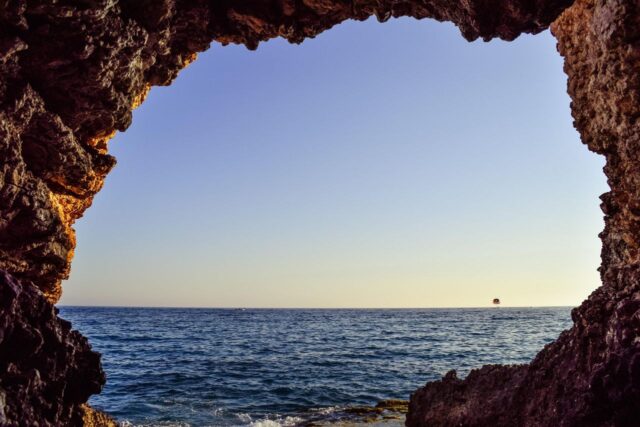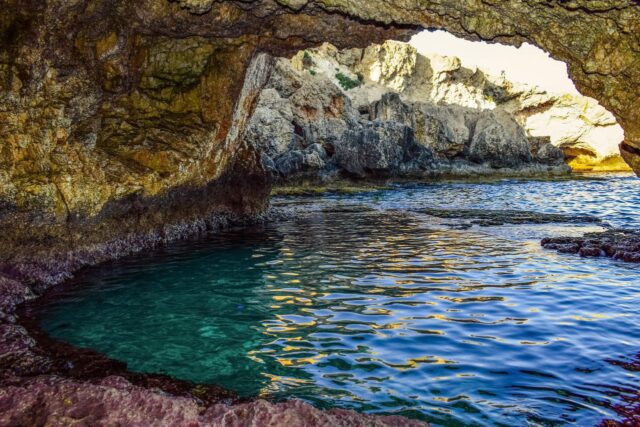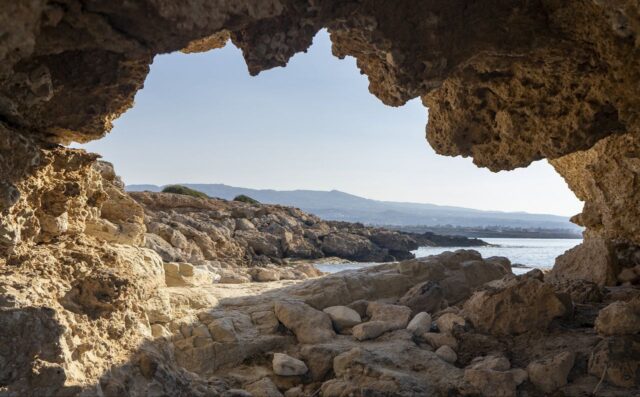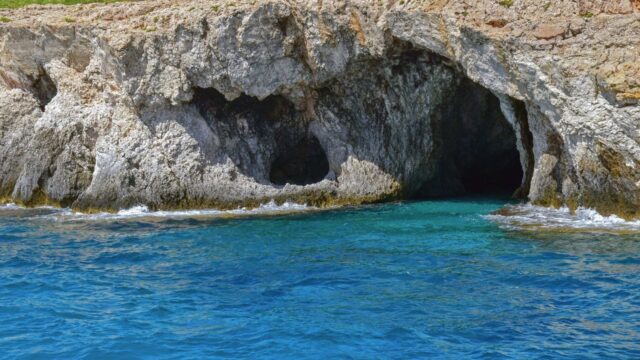The Sea Caves in Paphos are one of Cyprus’s most picturesque natural attractions. This stretch of coastline captivates with its stunning combination of rocky cliffs, turquoise water, and intricate rock formations sculpted by wind and sea over millennia. The Sea Caves are considered a must-see for travelers interested in nature, geology, and marine life.
The Paphos sea caves have become one of the most popular locations for photo shoots, video shoots, and wedding ceremonies. They are often chosen for their unique rock geometry and the color of the water, which changes depending on the time of day. The platform near the Edro III ship and the observation point above the Sea Caves arch are especially popular among tourists and photographers. Here you can watch the sunset, when the sun literally “sinks” into the sea.

Contents
Geographic location
The sea caves are located on the west coast of Cyprus, approximately 6–8 kilometers from Paphos, near the village of Peyia and Coral Bay beach. The area stretches along the coast for approximately 2 kilometers, including a picturesque cape with cliffs, natural arches, and grottoes, partially hidden underwater.
This place is part of the Akamas Peninsula Natural Area, known for its ecological purity and minimal human intervention.
The Sea Caves area has no designated swimming areas, so caution is advised. Cliff diving and swimming near exposed cliffs are dangerous due to underwater rocks and currents.
For swimming and snorkeling, it is better to choose small bays with a gentle slope, for example, near the Cap St. Georges hotel.
There are several cafes and viewing platforms nearby where you can relax and enjoy the sea view.

Formation of caves
The formation of sea caves is the result of the long-term interaction of wind, waves, and the limestone rocks that make up the coastline. Over centuries, the sea has eroded the soft limestone, creating a complex network of tunnels, arches, and depressions.
The sun and saltwater give the rocks a distinctive hue—from light gold to pinkish beige—and in the sunset, they appear fiery. Some caves reveal traces of ancient tectonic processes and marine sediments, making this stretch of coastline of interest to geologists.

Natural features and types
The sea caves of Paphos are famous for their high cliffs, reaching 10–15 meters, and deep grottoes accessible only by water. The most famous of them are located in the Sea Caves Avenue area, a road running along the coast with panoramic viewing platforms.
The coastline here is indented with bays and small capes. On clear days, the water near the caves is clear to a depth of 20 meters, revealing the sandy bottom and underwater arches.
The landscape is especially beautiful when the sun is low – in the morning or at sunset, when the play of light highlights the contrast between the blue sea and the white cliffs.

Sea Caves and the Edro III Ship
One of the main attractions of the Sea Caves area was the Edro III, a ship that washed ashore in December 2011 during a storm. The Sierra Leone-flagged vessel was en route from Limassol to Rhodes when it lost control and ran aground near the shore.
Today, it stands at the water’s edge, listing at an angle, becoming part of the landscape. The ship is not being removed due to the danger of environmental damage—it serves as a unique monument to the sea and the elements.
Edro III is one of the most photographed spots in Paphos. The ship looks especially stunning against the sunset sky as the sun sets below the horizon.
Marine life and diving
The waters around the caves attract scuba divers. The water is clear, and depths range from 3 to 15 meters. The underwater grottoes provide a haven for marine life: octopuses, sponges, starfish, scorpionfish, and colorful fish.
Local diving centers organize dives in Paphos’s sea caves, offering itineraries for both beginners and experienced divers. A particularly popular route takes you through underwater tunnels and small caves near the cape, where the water sparkles with every shade of blue.
For those who prefer a quieter experience, snorkeling is available —the water in the bays is clear, the current is weak, and the shore is convenient for entering the sea.

How to get there
There are several ways to reach the sea caves:
- By car. The drive from central Paphos takes about 15 minutes. Head toward Peyia and follow the signs for Sea Caves Road or Avakas Gorge. There is free parking along the road.
- By bus. From Paphos, take route #615 to the Coral Bay stop, then walk or take a taxi (about 3 km).
- By boat or yacht. Boat trips along the coastline are available from Paphos Port and Coral Bay, including stops at caves for swimming and photo opportunities.
For pedestrians, there are several trails leading to observation points and platforms that offer the best views of the coast.
When is the best time to visit?
You can visit the sea caves of Paphos all year round, but this place looks especially picturesque during the warm season – from April to October.
- Morning is the time of soft light, when the water is most transparent.
- Sunset is the highlight of the day, when the rocks and sea are painted in golden and pink hues.
- Winter is suitable for walks and photographs without tourists, although swimming at this time is only possible for the hardy.
It is worth considering that the coast is rocky, and the descent to the water can be steep, so comfortable shoes are recommended.

Surrounding areas and nearby attractions
Near the sea caves are:
- Coral Bay Beach is a popular place for relaxation and water activities.
- Akamas Nature Reserve is a natural park with rare plants and animals.
- Avakas Gorge is one of the most beautiful hiking spots in Cyprus.
- The Church of Saint George in Peyia is a small chapel with panoramic views of the coast.
These places are easy to visit in one day, combining a walk through the sea caves with a swim and dinner in a seaside tavern.
The Paphos Sea Caves are a natural gallery sculpted by the sea, wind, and time. Their cliffs, grottoes, and crystal-clear waters embody the beauty of the Cypriot coastline and the power of the elements. This place is a must-see for anyone who wants to see Cyprus not only as a beach resort but also as an island of amazing natural wonders.

















